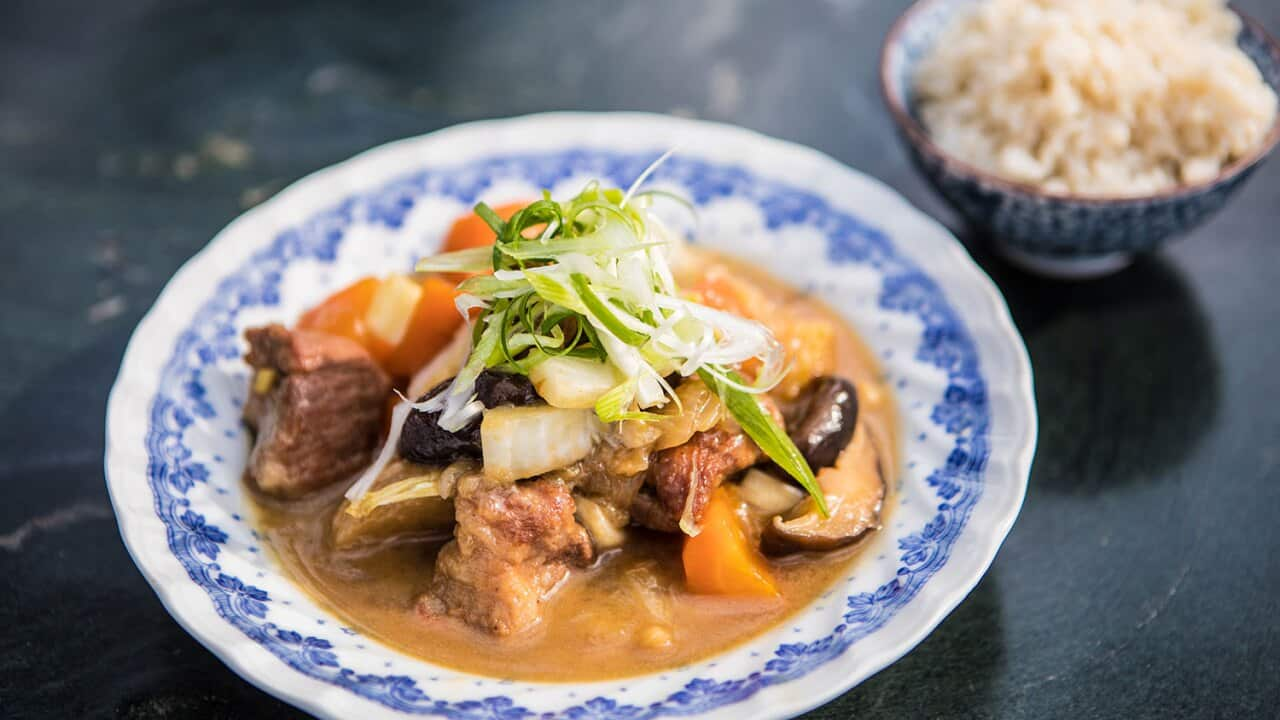This hearty pork stew is perfect for a cozy dinner. The tender chunks of pork shoulder combined with carrots, potatoes, and a rich chicken broth create a comforting and flavorful dish. It's a simple yet satisfying meal that will warm you up on a chilly evening.
If you don't usually cook with pork shoulder, you might need to visit the meat section of your supermarket. This cut of meat is ideal for stews because it becomes tender and flavorful when cooked slowly. Make sure to also grab tomato paste from the canned goods aisle, as it adds a rich depth to the stew.

Ingredients For Pork Stew Recipe
Pork shoulder: This cut of meat is perfect for slow cooking and becomes very tender.
Carrots: Adds sweetness and color to the stew.
Potatoes: Provides a hearty texture and helps thicken the stew.
Onion: Adds a savory base flavor.
Garlic: Enhances the overall taste with its aromatic qualities.
Chicken broth: Forms the liquid base of the stew, adding depth and richness.
Olive oil: Used for browning the pork and sautéing the vegetables.
Salt: Essential for seasoning and bringing out the flavors.
Black pepper: Adds a bit of heat and enhances the other flavors.
Tomato paste: Adds a rich, concentrated tomato flavor to the stew.
Technique Tip for This Stew
When browning the pork chunks, make sure not to overcrowd the pot. Overcrowding can cause the meat to steam rather than brown, which will affect the depth of flavor in your stew. Brown the pork in batches if necessary to ensure each piece develops a nice, caramelized crust.
Suggested Side Dishes
Alternative Ingredients
pork shoulder - Substitute with beef chuck: Beef chuck has a similar texture and flavor profile, making it a good alternative for a hearty stew.
pork shoulder - Substitute with lamb shoulder: Lamb shoulder provides a rich and robust flavor that complements the other ingredients in the stew.
sliced carrots - Substitute with parsnips: Parsnips offer a slightly sweeter and earthier flavor, adding depth to the stew.
diced potatoes - Substitute with sweet potatoes: Sweet potatoes add a touch of sweetness and a different texture, enhancing the overall flavor profile.
chopped onion - Substitute with leeks: Leeks provide a milder and slightly sweeter flavor compared to onions, which can add a subtle complexity to the stew.
minced garlic - Substitute with shallots: Shallots offer a milder garlic flavor with a hint of sweetness, making them a suitable replacement.
chicken broth - Substitute with vegetable broth: Vegetable broth is a great alternative for a lighter and vegetarian-friendly option.
olive oil - Substitute with canola oil: Canola oil has a neutral flavor and similar cooking properties, making it a good substitute for olive oil.
salt - Substitute with soy sauce: Soy sauce adds a savory umami flavor and can reduce the need for additional salt.
black pepper - Substitute with white pepper: White pepper provides a similar heat but with a slightly different flavor profile, offering a subtle change.
tomato paste - Substitute with crushed tomatoes: Crushed tomatoes add a similar tomato flavor and can provide a bit more texture to the stew.
Other Alternative Recipes Similar to This Stew
How To Store or Freeze Your Stew
- Allow the pork stew to cool completely before storing. This helps to prevent condensation, which can lead to a watery stew.
- Transfer the cooled stew into airtight containers. For portion control, consider using smaller containers that hold individual servings.
- Label each container with the date of preparation. This ensures you can keep track of how long the stew has been stored.
- Store the containers in the refrigerator if you plan to consume the stew within 3-4 days. The pork stew will maintain its flavor and texture during this period.
- For longer storage, place the containers in the freezer. The stew can be frozen for up to 3 months without significant loss of quality.
- When ready to reheat, thaw the stew in the refrigerator overnight if frozen. This gradual thawing helps to preserve the texture of the vegetables and meat.
- Reheat the pork stew on the stovetop over medium heat, stirring occasionally, until it reaches the desired temperature. Alternatively, you can reheat it in the microwave, stirring halfway through to ensure even heating.
- If the stew appears too thick after reheating, add a splash of chicken broth or water to reach your preferred consistency.
- Enjoy your reheated pork stew with a fresh slice of crusty bread or a side salad for a complete meal.
How To Reheat Leftovers
For stovetop reheating:
- Place the leftover pork stew in a pot.
- Add a splash of chicken broth or water to maintain moisture.
- Heat over medium-low heat, stirring occasionally, until the stew is heated through.
For microwave reheating:
- Transfer the pork stew to a microwave-safe dish.
- Cover with a microwave-safe lid or plastic wrap, leaving a small vent.
- Heat on medium power for 2-3 minutes, stirring halfway through. Continue heating in 1-minute increments until hot.
For oven reheating:
- Preheat your oven to 350°F (175°C).
- Place the pork stew in an oven-safe dish.
- Cover with aluminum foil to prevent drying out.
- Heat for 20-30 minutes, or until the stew is bubbling and thoroughly heated.
For slow cooker reheating:
- Transfer the pork stew to your slow cooker.
- Set to low heat.
- Heat for 1-2 hours, stirring occasionally, until the stew is hot.
For sous vide reheating:
- Place the leftover pork stew in a vacuum-sealed bag.
- Set your sous vide machine to 165°F (74°C).
- Submerge the bag in the water bath and heat for 1 hour, ensuring the stew is evenly warmed.
Best Tools for Making This Stew
Large pot: A deep and spacious pot is essential for browning the pork and simmering the stew.
Wooden spoon: Ideal for stirring the ingredients without scratching the pot.
Cutting board: Provides a stable surface for chopping the vegetables and meat.
Chef's knife: A sharp knife is crucial for efficiently cutting the pork, carrots, potatoes, and onions.
Measuring cups: Used to measure out the precise amounts of carrots, potatoes, and chicken broth.
Measuring spoons: Necessary for measuring the olive oil, salt, pepper, and tomato paste.
Garlic press: Handy for mincing the garlic cloves quickly and efficiently.
Tongs: Useful for turning and removing the pork chunks from the pot.
Ladle: Perfect for serving the hot stew into bowls.
Bowls: Used for setting aside the browned pork and for serving the finished stew.
How to Save Time on Making This Stew
Prepare ingredients in advance: Chop onions, carrots, and potatoes the night before to save time on cooking day.
Use a slow cooker: Transfer browned pork and other ingredients to a slow cooker and let it cook on low for 6-8 hours.
Pre-measure spices: Measure out salt, black pepper, and tomato paste before starting to cook.
Batch cooking: Double the recipe and freeze half for a quick meal later.
One-pot method: Use a single large pot to reduce cleanup time.

Pork Stew Recipe
Ingredients
Main Ingredients
- 1 kg Pork shoulder cut into chunks
- 2 cups Carrots sliced
- 2 cups Potatoes diced
- 1 cup Onion chopped
- 3 cloves Garlic minced
- 4 cups Chicken broth
- 2 tablespoon Olive oil
- 1 teaspoon Salt to taste
- 1 teaspoon Black pepper to taste
- 2 tablespoon Tomato paste
Instructions
- 1. Heat olive oil in a large pot over medium heat.
- 2. Add pork chunks and brown on all sides.
- 3. Remove pork and set aside.
- 4. In the same pot, add onions and garlic, sauté until translucent.
- 5. Stir in tomato paste and cook for another minute.
- 6. Return pork to the pot, add carrots, potatoes, and chicken broth.
- 7. Season with salt and pepper.
- 8. Bring to a boil, then reduce heat and simmer for 2 hours.
- 9. Serve hot.
Nutritional Value
Keywords
Suggested Appetizers and Desserts for This Stew
More Amazing Recipes to Try 🙂
- Air Fryer Meatballs Recipe25 Minutes
- Loaded Baked Potato Salad Recipe35 Minutes
- Crumpets Recipe35 Minutes
- Grilled Cheese and Peanut Butter Sandwich Recipe10 Minutes
- Italian Spaghetti Sauce with Meatballs Recipe1 Hours
- Strawberry Salad Recipe10 Minutes
- Microwave Baked Potato Recipe15 Minutes
- Mango Banana Smoothie Recipe10 Minutes

Leave a Reply